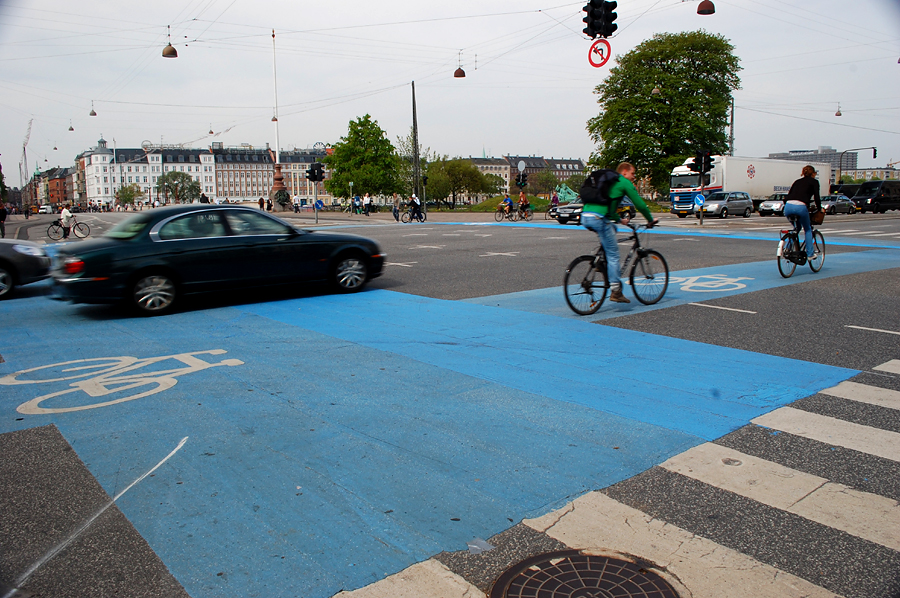

This new, regular feature will offer up an idea for how to improve Toronto’s public spaces. Some of the concepts discussed will have implementation examples from elsewhere in the world, and others will be as yet untested. Each post will conclude with a question to lead off what we hope will be a lively discussion in the comments section about the idea.
![]()
Bike lanes continue to be a controversial topic in Toronto. Mayoral candidate Rocco Rossi has vowed to relegate bike lanes to side streets and back alleys, while fellow candidate George Smitherman is blowing the whistle on the issue and calling for a “time out” on Toronto’s bike lane plans. Jarvis Street has become the proxy war zone for the city’s bike lane battle, where car lovers and bike lovers alike can throw in their two cents about the issue. Not to mention the Paula Fletcher voting debacle at City Council, which cost the city a much-needed dedicated bike lane on University Avenue. But as the battle over bike lanes goes on, it’s time to look for some tangible ways of improving cyclist safety in Toronto.
Portland, Oregon installed blue bike lanes at intersections over a decade ago in an effort to improve cyclist safety (see signage above). The coloured bike lanes span intersections where there are conflicts between cyclist and motorist rights-of-way. A 2003 City of Toronto study reported that the majority of bike-car collisions in Toronto occur at intersections where the motorist is performing a turning maneuver.
The Portland blue bike lanes project has shown that cyclists feel 50% safer biking on the coloured anes. Further results show there has been a 20% increase in motorists yielding for cyclists due to visibility and awareness. A similar study conducted in Denmark found that coloured bike lanes reduced bike-car collisions by 38% and reduced fatalities and serious injuries by 71%.
Many other cities use coloured bike lane markings to reduce conflicts between cyclists and motorists. The colours range from red in the Netherlands, Germany, Sweden, and Belgium, to blue in Denmark, yellow in Switzerland, and green in France. Portland chose to use blue, so as not to conflict with yellow (the colour of the road lines) and red and green (the colour of the traffic lights and stop signs). Blue also shows up relatively well for people with colour blindness.
The City of Toronto seems intent on using paint markings to define the city’s bike lanes as opposed to phsyically separated lanes, and Portland shares the same attitude. Prior to the blue colouring, bike lanes in Portland were marked with white dashes, similar to Toronto’s. Thermoplastics were used to colour the bike lanes, as they hold up much better to wear and tear than traditional paints. Accompanying road signs were installed to depict when motorists should yield to cyclists.
The overall effect of the Portland project has been an increased awareness of the interaction between cyclists and motorists in the city. Bike lanes are a crucial piece of infrastructure in any major city, and a simple measure like colouring the lanes can have a large impact on cyclist safety.
What would coloured bike lanes do for Toronto’s efforts to increase and promote cycling? Add your comments below.








14 comments
I’d be rather more about Advance Stop Lines, but these have to be done right to work at all.
What we need to do is get the bicycles OFF THE SIDEWALKS first. Give the cyclists no choice but to ride on the streets. Once you get all cyclists on the streets, cars get used to driving with them there.
Right now the police do nothing about the fact that half the cyclists are not where they’re supposed to be anyway. Motorists are now not expecting them to be on the street.
Unfortunately our laws are a joke because it’s tied to tire size and many idiots are getting around the law by riding altered kids’ bikes or bringing their kids onto the sidewalks of major roads to teach them how to ride.
Change the laws so that riding on the sidewalk is not allowed by any bike on a road where the speed is 41KM or more. That keeps kids and their small wheeled bikes on sidestreets only — which is where they should be until they’re old enough, big enough and experienced enough to join the riders on the streets of the main arteries. And it makes it obvious to police how many people are operating their bikes illegally.
I’m tired of getting buzzed by cyclists on the sidewalk as I try to walk to the subway each day. Often in the five minute walk I have, at least 3 are buzzing past, riding erratically and dangerously ON THE SIDEWALK.
Get them off the sidewalks first with no excuses. Get the cars used to them being on the street and then we can judge the need for bike lanes.
I’m pretty sure there are already some blue bike lanes in Toronto – that path that runs parallel to Lakeshore by the EX. Of course, this is not really a ‘bike lane’ as it is not on the street/road.
This is a whole lot of win. I especially like the signage that accompanies it.
The only problem I see is that paint will wear out eventually, and will require repainting.
The same exists here in bike utopia, Amsterdam. The pavement is a different colour in bike lanes, ensuring pedestrians and cars know to keep out. Simple and effective.
Ginnée, you want cyclists to get killed FIRST, before proper infrastructure is brought in?
Of course laws agains adults riding on sidewalks should be enforced, not the slightest argument with you there. I’m not sure there is a law about tire size, as there are many folders and other small-wheel bicycles for adults, and I’ve often had old 24″ wheel bikes – I’m short.
There are the arsehole cyclists (also known as lycra louts), who are just plain inconsiderate, like a lot of drivers, and a fair number of pedestrians who walk in or across bicycle lanes without looking. Enforcement is the only arm against such people. But there are also a lot of cyclists who are just plain scared. I’ll cite an example here in Montréal – a lady I know who is a bit frail and well into her 70s – almost 80 – but who loves to ride her bicycle and keeps her health up doing so. She has been stopped by police for doing so although I doubt she rides fast enough to hurt or scare most pedestrians. If she had the benefit of bicycle lanes as exist in Copenhagen or Amsterdam she could ride safely (faster cyclists would simply pass her) and she wouldn’t be on the sidewalk.
In Amsterdam the colour is actually integrated into the paving of the bicycle paths. In Copenhagen it is paint, but many paths are raised a bit, as in Amsterdam. A Le Droit (Ottawa/Gatineau) journalist is currently in Copenhagen for Velo-City, the international bicycle conference, and he says the surface is not slippery – there is snow and ice in Copenhagen too, and the bicycle paths are ploughed there with the little sidewalk ploughs we call “chenillettes” in French.
I have been to Copenhagen for a brief conference but never cycled there; I have cycled in Amsterdam many times when there for work and research. People of all ages from children to seniors well into their 80s cycle safely in both those cities and many others.
see: http://www.copenhagenize.com http://www.amsterdamize.com
I took a picture of the new bike lanes on the Queensway at the exit to South Kingsway as an example of what the city is doing now. It is a dangerous intersection for cyclists. I don’t know if what they did would be better then blue paint or not.
I love the idea of colored bike lanes, however, I would be concerned that they be used as parking spots as the sharrows are on College and other streets. This is maddening to say the least!
As of 2008 Portland is using a bright green paint, rather than blue. The biggest problem with it is that the paint is a little slippery when it’s wet. Oh well, it puts a little more pressure on the hipsters to install a brake ^_^
Darwin, that bikelane looks too flamboyant and offensive to me. lol. Couldn’t they have spaced out the markers a bit more? As it is, it’s very crowded. I think just coloring it is a better idea.
I wish I had caught this post when it came out 2 days ago!
I have just moved to London UK where these lanes have been implemented extensively. While locals are not always gung ho ( http://www.londoncyclist.co.uk/news/what-the-12-cycle-superhighways-mean-for-london-cyclists/ ) from a Toronto-ist’s perspective they’ve great. Painted lanes are a part of my everyday commute and I love ’em ( http://416expat.wordpress.com/2010/05/14/this-is-how-i-go-to-work/ ).
Another view: ( http://416expat.wordpress.com/2010/06/03/londons-bike-network/ )
Eddie, the bike lane is only like that at the exit. The rest of it is painted as a typical Toronto bike lane.
Fabulous idea. As a cyclist who crosses the Bloor Danforth viaduct daily I would love to see a blue lane on that crazy eastbound stretch where cyclists have to cross through a lane of traffic that is turning off to the DVP. I have to say that most motorists are very considerate and give way…. until the jerk on Wednesday who honked, swore and sped around me to get onto the DVP, which incidentally was backed up. I suppose the blue lane wouldn’t actually change his behaviour but I still endorse the idea that will get motorists to think about cyclists. (I am also a motorist so know how challenging it can be).